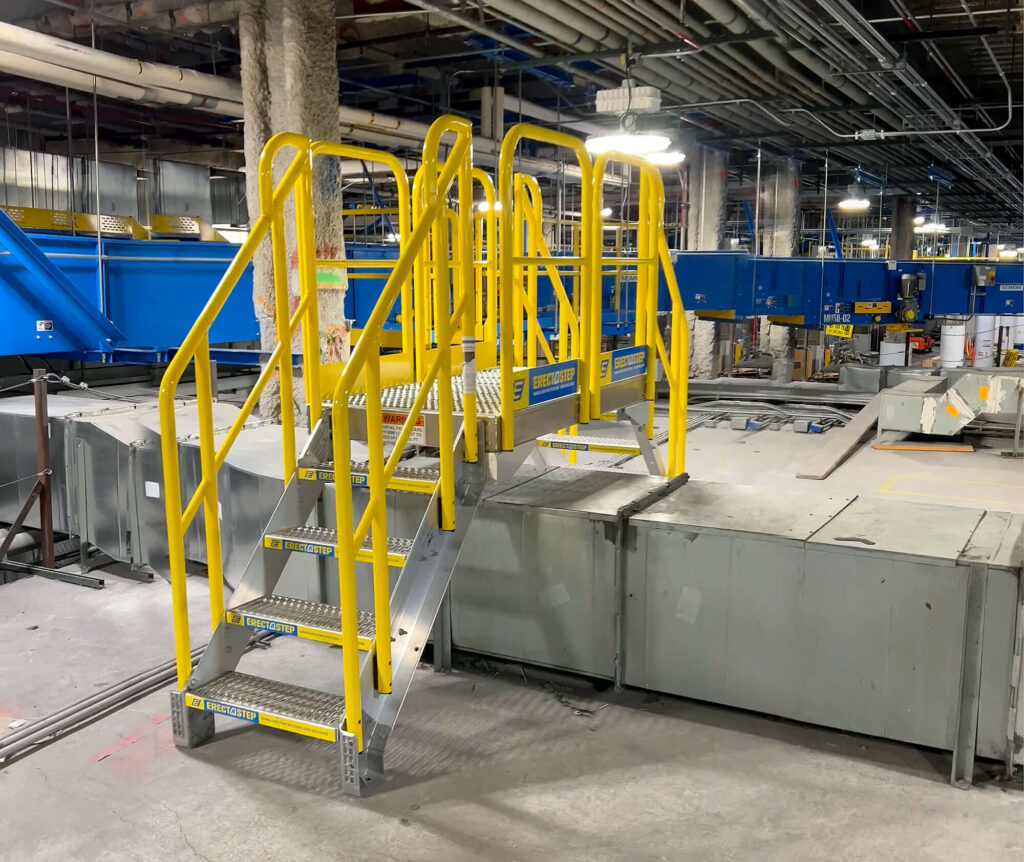Get a quote, configure a custom stair or ask a question. We're here to help!
Denver Airport stair crossover over an air duct
View All Industrial%20Stairs InstallationsAn ErectaStep crossover gives workers safe access to remove jams on a luggage conveyor belt beneath the Denver Airport.
Due to the high foot traffic in these buildings, airport terminals require very advanced heating, ventilation, and air conditioning (HVAC) systems. Furthermore, diverse occupancy classes in a terminal building necessitate varying degrees of cross ventilation, temperature, and moisture levels.
Aluminum is a popular material for airport terminal equipment because it is strong and lightweight. However, aluminum is also susceptible to corrosion, which can be problematic in areas with high humidity levels. Rust can cause aluminum to weaken, making it more likely to break or crumble. In addition, rust can be unsightly, making airport terminal facilities look old and rundown. Several ways prevent rust from forming on aluminum, including keeping the metal clean and dry and using rust-resistant paint or coating. By taking these precautions, you can help to keep your airport terminal equipment looking its best.
While most people think rust only affects iron and steel, it can occur on any metal exposed to oxygen and moisture. This includes aluminum, often used in outdoor applications due to its corrosion resistance. However, aluminum is not immune to rust, and the high humidity levels in Denver can create the perfect conditions for this type of corrosion. When aluminum is exposed to oxygen and moisture, a thin layer of aluminum oxide forms on the surface of the metal. This oxidizing layer like zinc is actually what gives aluminum its corrosion resistance. However, if this layer is breached, the aluminum underneath can start to oxidize and form rust. While aluminum rust is not as dangerous as iron rust, it can still cause structural damage to buildings and other structures over time. For this reason, it is important to be aware of the potential metal stairs deterioration and take steps to prevent it.
Crossover stairs are metal stairs that provide access to areas of a building that are blocked by air ducts or other obstacles. They are commonly used in HVAC systems, allowing technicians to safely and easily reach the equipment they need to service. Crossover stairs are typically made of metal, making them durable and able to withstand heavy use. They are also available in various sizes and configurations, so they can be customized to fit the specific needs of any space. Whether you need access to an HVAC unit or simply want a safe and convenient way to reach an upper level, our line of industrial stairs can provide the ideal solution.
Powder coating metal stairs is an effective way to further protect them against rust. Powder coatings are a type of paint that is applied in powder form and cured under heat. This process creates a harder and more durable finish than traditional paint, making it ideal for metal surfaces exposed to the elements. In addition to providing an extra layer of protection against rust, powder coatings can also improve the appearance of metal stairs by creating a smooth, glossy finish. As a result, powder coating is an ideal way to safeguard metal stairs against corrosion and wear.
You bet our stairs are corrosion-resistant and can be used indoors and outdoors. Crossover stairs cannot just provide access to bulky air ducts. Still, they can also be a solution to provide access above conveyor systems and other impediments in factories and different commercial settings. These stairs have modular parts, easy to install, and can be made to meet OSHA-approved size or weight requirements.
As we adjust to life in a post-pandemic environment, the strategy for safeguarding airport passengers and workers will need to evolve as people become more aware of the significance of maintaining high indoor air quality. Consistent and speedy air duct maintenance by installing durable crossover stairs within the HVAC equipment room.
Because every airport terminal is customized to its specific location, it is essential to plan your HVAC system concurrently with the passenger transit design process and the maintenance team’s workflow as early on in air terminal operations as possible. Knowing what works and what does not necessitates using engineers with extensive knowledge in aviation and specialized building design.









